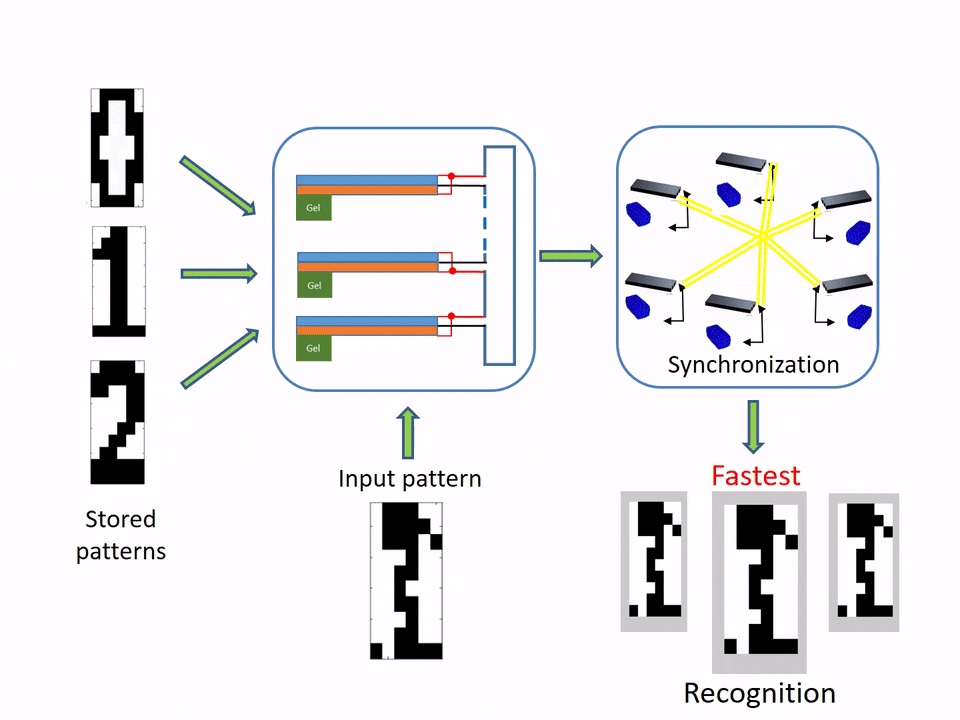
via www.engineering.pitt.edu
The potential to develop “materials that compute” has taken another leap at the University of Pittsburgh’s Swanson School of Engineering, where researchers for the first time have demonstrated that the material can be designed to recognize simple patterns. This responsive, hybrid material, powered by its own chemical reactions, could one day be integrated into clothing and used to monitor the human body, or developed as a skin for “squishy” robots.
“Pattern recognition for materials that compute,” published today in the AAAS journal Science Advances (DOI: 10.1126/sciadv.1601114), continues the research of Anna C. Balazs, Distinguished Professor of Chemical and Petroleum Engineering, and Steven P. Levitan, the John A. Jurenko Professor of Electrical and Computer Engineering. Co-investigators are Yan Fang, lead author and graduate student researcher in the Department of Electrical and Computer Engineering; and Victor V. Yashin, Research Assistant Professor of Chemical and Petroleum Engineering.
The computations were modeled utilizing Belousov-Zhabotinsky (BZ) gels, a substance that oscillates in the absence of external stimuli, with an overlaying piezoelectric (PZ) cantilever. These so-called BZ-PZ units combine Dr. Balazs’ research in BZ gels and Dr. Levitan’s expertise in computational modeling and oscillator-based computing systems.
“BZ-PZ computations are not digital, like most people are familiar with, and so to recognize something like a blurred pattern within an image requires nonconventional computing,” Dr. Balazs explained. “For the first time, we have been able to show how these materials would perform the computations for pattern recognition.”
Dr. Levitan and Mr. Fang first stored a pattern of numbers as a set of polarities in the BZ-PZ units, and the input patterns are coded through the initial phase of the oscillations imposed on these units. The computational modeling revealed that the input pattern closest to the stored pattern exhibits the fastest convergence time to the stable synchronization behavior, and is the most effective at recognizing patterns. In this study, the materials were programmed to recognize black-and-white pixels in the shape of numbers that had been distorted.
Compared to a traditional computer, these computations are slow and take minutes. However, Dr. Yashin notes that the results are similar to nature, which moves at a “snail’s pace.”
“Individual events are slow because the period of the BZ oscillations is slow,” Dr. Yashin said. “However, there are some tasks that need a longer analysis, and are more natural in function. That’s why this type of system is perfect to monitor environments like the human body.”
For example, Dr. Yashin said that patients recovering from a hand injury could wear a glove that monitors movement, and can inform doctors whether the hand is healing properly or if the patient has improved mobility. Another use would be to monitor individuals at risk for early onset Alzheimer’s, by wearing footwear that would analyze gait and compare results against normal movements, or a garment that monitors cardiovascular activity for people at risk of heart disease or stroke.
Since the devices convert chemical reactions to electrical energy, there would be no need for external electrical power. This would also be ideal for a robot or other device that could utilize the material as a sensory skin.
“Our next goal is to expand from analyzing black-and-white pixels to grayscale and more complicated images and shapes, as well as to enhance the devices storage capability,” Mr. Fang said. “This was an exciting step for us and reveals that the concept of “materials that compute” is viable.”
The Latest on: Materials that compute
[google_news title=”” keyword=”Materials that compute” num_posts=”10″ blurb_length=”0″ show_thumb=”left”]
via Google News
The Latest on: Materials that compute
- Materials Gain on Rate Bets - Materials Roundupon May 9, 2024 at 2:07 pm
Producers of metals and other raw materials rose, and the sector tested all-time highs amid renewed hopes for rate cuts later this year. The SPDR ...
- Materials science articles from across Nature Portfolioon May 5, 2024 at 5:00 pm
Materials science is an interdisciplinary field concerned with the understanding and application of the properties of matter. Materials scientists study the connections between the underlying ...
- Best Basic Materials Stockon May 3, 2024 at 5:01 pm
Materials stocks are essential to the metabolism of society because this sector is responsible for producing the raw materials used by all other sectors of the stock market. That's why it's ...
- 10 Top Materials Stocks Of May 2024on May 2, 2024 at 5:11 am
Commissions do not affect our editors' opinions or evaluations. Materials like metal, concrete and chemicals are the foundation of the global economy—every sector requires basic materials ...
- Here's Why We're Watching Nano One Materials' (TSE:NANO) Cash Burn Situationon May 1, 2024 at 7:13 am
Even when a business is losing money, it's possible for shareholders to make money if they buy a good business at ...
- New class of spongy materials can self-assemble into precisely controllable structureson April 30, 2024 at 8:02 am
A team of researchers led by the University of Massachusetts Amherst has drawn inspiration from a wide variety of natural geometric motifs—including those of 12-sided dice and potato chips—in order to ...
- 12 types of roofing materials: Guide to choosing the best ones for youon April 28, 2024 at 5:00 pm
The type of roofing material you select can have a big impact on your home’s appearance, energy efficiency and ability to withstand the elements. In general, asphalt shingles make up the ...
- How Companies Calculate Revenueon April 26, 2024 at 5:00 pm
There is a standard way that most companies calculate revenue. Regardless of the method used, companies often report net revenue (which excludes things like discounts and refunds) instead of gross ...
- Laser light makes a material magneticon April 25, 2024 at 5:00 pm
Pulses of laser light can cause any material – including insulators – to develop a relatively large magnetic moment. This effect, which has been demonstrated for the first time by an international ...
via Bing News










